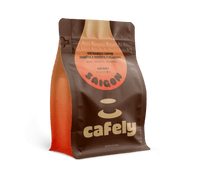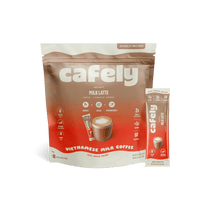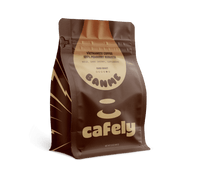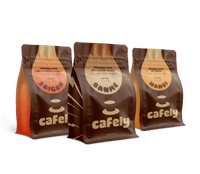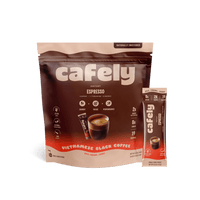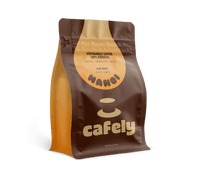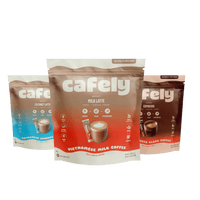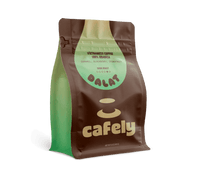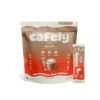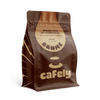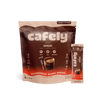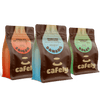Making cold brew coffee is surprisingly simple. However, without the right equipment, filtering the final result can be difficult.
A good glass of cold brew should be bright, naturally sweet, and have a light, smooth mouthfeel. Filtration is essential if you want to achieve these qualities.
In this guide, you'll learn how to make and filter cold brew coffee the best way — by using a French press — and three alternative ways to filter the brew if you don't have the right equipment.
What is Cold Brew Coffee?
Cold brew coffee is a chilled beverage made by steeping coarsely ground coffee in cold water for several hours in the fridge — 18–24 hours produces the best results. It's then filtered to remove the grounds and served over ice.
Cold brew coffee is smooth, naturally sweet, and less acidic than regular hot-brewed coffee. This is because the lower temperature extracts fewer bitter compounds from the beans.
It's also much stronger than hot brewed coffee and iced coffee because the slower extraction process produces a much more concentrated brew.
Easiest Way to Filter Cold Brew Coffee: The French Press Method

The best way to make cold brew is to use a French press. These simple coffee brewers are made up of a glass container, a lid, and a mesh plunger that separates the grounds from the brew.
Alongside a basic pour-over setup, the French press is the cheapest coffee maker money can buy. If you're serious about making cold brew regularly, it's definitely worth spending the $15 to $20 on one.
With that said, here's how to make cold brew coffee using a French press:
What You Need:
- High-Quality Coffee — Opt for high-quality, whole-bean coffee and grind it fresh.
- Cold Water — Use fresh, cold, filtered water for the best cold brew.
- Ice — Cold brew coffee is best served over ice.
- Coffee Grinder — The best cold brew is made from fresh, whole-bean coffee. You'll need a burr or blade grinder to grind the beans properly.
- Coffee Measure — Use a coffee measure or weighing scale to accurately portion your coffee.
- French Press — A French press is essential for this recipe. If you want to drink cold brew regularly, opt for a large-capacity press.
1. Measure & Grind the Coffee
First, you’ll need to measure and grind your coffee. How much coffee you’ll need depends on the size of your French press and how much cold brew you wish to make. A coffee-to-water ratio of 1:8 works best for cold brew.
Use a burr or blade grinder to prepare your whole beans. Aim for a coarse grind — similar in texture to unprocessed sea salt.
Use the table below to calculate how much coffee and water you need:
|
French Press Size |
Servings (No.) |
Coffee (Grams & Tbsp) |
Water (oz. & mL) |
|
3-Cup French Press |
1–2 servings |
27 grams (5 tbsp) |
7.5 oz (220 mL) |
|
4-Cup French Press |
3–4 servings |
45 grams (8–9 tbsp) |
12 oz (350 mL) |
|
8-Cup French Press |
6–8 servings |
80 grams (15–16 tbsp) |
22 oz (650 mL) |
|
12-Cup French Press |
10–12 servings |
125 grams (23–25 tbsp) |
34 oz (1000 mL) |
2. Add the Coffee & Water to the French Press
Next, add your fresh coffee grounds to the bottom of your French press and then pour in the required amount of water. Make sure to use fresh, cold, filtered water.
Gently stir the coffee and water until the grounds are completely saturated.
3. Refrigerate to Brew
Place the lid on your French press and put it in the refrigerator. You may need to remove the plunger from your press, so the container fits inside your fridge.
Let the brew steep for 18–24 hours. The longer you leave it, the stronger your cold brew will be. Don’t worry about stirring it while it’s brewing — it’s best to let the mixture “do its thing.” This will allow the grounds to naturally settle at the bottom of the container.
4. Strain the Coffee
After 18–24 hours, remove the French press from the fridge. Push the plunger on your French press through the brew slowly to separate the grounds. Don’t toss them out just yet — used coffee grounds are useful for composting, deodorizing, or even skincare routines.
5. Pour & Serve
Pour your coffee into a clean resealable container. Leaving the brew in the press with the grounds for storage will eventually lead to over-extraction, so this is an important step.
If you’re ready to enjoy your cold brew, add a handful of ice to a glass before pouring. We think cold brew is best served black and unsweetened, but you may want to add sugar, syrup, a splash of milk, and/or make your own coffee creamer.
How to Filter Cold Brew Coffee Without a Press

Don’t have a French press or fancy cold brew kit? No worries — you can still make smooth, delicious cold brew coffee at home with a few simple tools.
Follow steps one to three in the guide above, but use a large jar or jug instead of a French press. Then, select one of the filtration methods below to strain the brew.
Here's how to filter cold brew coffee effectively using what you already have (3 ways):
1. Using Paper Coffee Filters
The best way to filter cold brew coffee outside of using a French press is to use paper coffee filters. Filtering cold brew with a paper coffee filter results in a smooth, clean beverage with a light mouthfeel.
To filter cold brew with a paper filter, use a pour-over setup like the Hario V60, three-holed Kalita Wave, or Chemex brewer. If you don’t have a pour-over, a funnel or fine-mesh sieve will work but it’s not as efficient.
Pre-moisten your coffee filter and place the pour-over above a storage container or serving glass. Remove your pre-steeped cold brew from the fridge and gradually pour it into the filter to prevent tearing or clogging. Wait for the brew to drip through before adding more.
If you have made a large volume of cold brew, you need to strain, and you may need to change the filter once or twice throughout the process.
2. Using a Cheesecloth or Nut Milk Bag
A reusable cheesecloth or nut milk bag can be used to filter large batches of cold brew. This method removes the majority of coarse grounds from the brew, but finer particles may pass through, providing a slightly silty mouthfeel.
To filter cold brew coffee with a cheesecloth or nut milk bag, line a strainer, sieve, or colander with the cloth, place it over a large bowl or jar, and gradually pour in the steeped coffee. Allow the brew to drip through, and then bundle the cloth up and squeeze out the remaining liquid.
Cheesecloths and nutbags can vary in fineness. If you find that your brew is too silty, try doubling up the fabric. Leaving the strained brew to settle in the fridge will also improve the mouthfeel of the brew, as the fine particles fall to the bottom of the container. This usually takes a couple of hours.
3. Using a Kitchen Towel or T-Shirt
If you’re really out of options and can’t get to the store for a cheesecloth or coffee filter, you can use a clean, lint-free kitchen towel or cotton T-shirt to filter your cold brew.
This is definitely not the best way to filter your coffee but it’ll work in a pinch.
Simply drape the fabric over a bowl and secure it in place with a rubber band, making sure there’s a cavity underneath to collect the strained coffee. Slowly pour your brewed coffee over the fabric and let gravity do the rest.
This method can take some time — you may need to wait for 30 minutes to an hour for the brew to pass through the fabric. Once 90% of the brew has passed through, remove the rubber band and squeeze the remaining liquid out.
Make sure to use a tightly woven towel or shirt — this will catch more grounds. It’s also wise to store your cold brew in the fridge for a couple of hours after straining to allow any finer coffee grounds to settle.
FAQs: Filtering Cold Brew Coffee
Do you want to learn more about cold brew coffee and other chilled, caffeinated beverages?
Check out the answers to the frequently asked questions below:
1. Is Cold Brew Coffee Healthier Than Regular Coffee?
Cold brew isn't necessarily “healthier” than regular hot-brewed coffee, but it is less acidic, which could be easier in the stomach. However, cold brew tends to have a higher caffeine content and slightly less antioxidants than regular coffee. For those with sensitivity to acidity, looking into the best low-acid options for acid reflux may also be helpful.
2. How Much Caffeine is in a Cup of Cold Brew Coffee?
Cold brew coffee is surprisingly strong and may contain more caffeine per milliliter than regular drip or pour-over coffee. The average eight-ounce (240 mL) cup of cold brew contains somewhere between 100 and 200 mg of caffeine, depending on the type of beans used and the length of time it's left to steep before straining.
3. Can You Make Cold Brew Coffee With a French Press?
Yes. Using a French press is one of the best ways to make cold brew coffee. To make cold brew coffee with a French press, simply add ground coffee and cold water to the brewer and refrigerate for 16 to 24 hours. Then, remove the container from the fridge, strain by pressing the plunger down slowly, and store the cold brew in a separate container or serve.
4. Can You Make Cold Brew Coffee With a Pour-Over?
You can't make cold brew using a pour-over because the process requires submersion. Ground coffee must be submerged in cold water for several hours to extract the flavors, aromas, and caffeine from the coffee. With that said, you can strain pre-filtered cold brew using a pour-over setup such as the Hario V60 — this results in a clean cup of coffee with a light mouthfeel.
5. What’s the Difference Between Cold Brew & Iced Coffee?
Cold brew and iced coffee are both chilled beverages. However, cold brew is made by soaking ground coffee in cold water, and iced coffee is typically made by cooling and diluting hot-brewed coffee with water or milk. Cold brew tends to be stronger and less acidic than iced coffee and is served black. Iced coffee is normally served with milk or cream and is usually sweetened with sugar or syrup.
6. Can You Add Milk to Cold Brew Coffee?

Yes. You can add milk to cold brew coffee to create a creamy iced beverage. You can also add ice, sugar, or flavored syrup to alter its flavor and mouthfeel.
7. Can You Heat Cold Brew Coffee?
Yes. You can heat up cold brew coffee if you want to enjoy a high-strength, low-acidity coffee that's warm. To heat cold brew, simply add a serving to a pan and warm on the stove gently until steaming but not boiling.
8. What’s the Best Coffee for Cold Brew?
The best coffee for cold brew should be high-quality and freshly ground. Opt for a whole bean coffee from a reputable supplier. Whether you choose arabica, robusta, or a blend of both beans is up to you. Arabica's light, more nuanced flavor profile coffee creates a naturally sweet, smooth brew, while robusta coffee produces a bold, dark, slightly bitter brew with a strong caffeine hit. Blends, like our SaiGon beans, offer the qualities of both.
9. What’s the Best Grind Size for Cold Brew Coffee?
The best grind size for cold brew coffee is medium-coarse to coarse. The large grind size ensures the coffee is perfectly extracted, and it makes filtration easier.
10. What’s the Best Way to Make Cold Brew?
The easiest way to make cold brew coffee is to use a French press. Simply submerge ground coffee in cold water overnight and push down the plunger to strain the brew.
